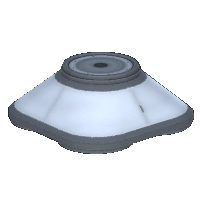Difference between revisions of "TVR-2160C Mk2 Stack Quad-Coupler"
From Kerbal Space Program Wiki
m |
|||
| Line 1: | Line 1: | ||
{{:TVR-2160C Mk2 Stack Quad-Coupler/Box}} | {{:TVR-2160C Mk2 Stack Quad-Coupler/Box}} | ||
{{Stub||}} | {{Stub||}} | ||
| − | The '''TVR-2160C Stack Quad Coupler''' is an adapter that was added in version 0.21 in KSP. The Quad Coupler is useful in some ways, tying with the [[TVR-400L Stack Quad-Adapter]] for the part with the most nodes. | + | The '''TVR-2160C Stack Quad Coupler''' is an adapter that was added in version 0.21 in KSP. The Quad Coupler is useful in some ways, tying with the [[TVR-400L Stack Quad-Adapter]] for the part with the most nodes. It is typically used to separate a simgle size 1 (1.25 meter) stack into four separate stacks. It supports fuel crossfeed. |
The quadcoupler has non-standard (0.3 instead of 0.2) drag, meaning it should be placed behind the center of mass to ensure stability. Given its intended function, this can be problematic. | The quadcoupler has non-standard (0.3 instead of 0.2) drag, meaning it should be placed behind the center of mass to ensure stability. Given its intended function, this can be problematic. | ||
Revision as of 03:00, 14 February 2015
| TVR-2160C Mk2 Stack Quad-Coupler | ||
| Adapter by O.M.B. Demolition Enterprises | ||
| Radial size | Small | |
| Cost | (total) | 2 000.00 |
| Mass | (total) | 0.175 t |
| Drag | 0.3 | |
| Max. Temp. | 2000 K | |
| Impact Tolerance | 12 m/s | |
| Research | | |
| Unlock cost | 4 200 | |
| Since version | 0.21 | |
| Part configuration | stackQuadCoupler.cfg | |
| Packed volume | None | |
The TVR-2160C Stack Quad Coupler is an adapter that was added in version 0.21 in KSP. The Quad Coupler is useful in some ways, tying with the TVR-400L Stack Quad-Adapter for the part with the most nodes. It is typically used to separate a simgle size 1 (1.25 meter) stack into four separate stacks. It supports fuel crossfeed.
The quadcoupler has non-standard (0.3 instead of 0.2) drag, meaning it should be placed behind the center of mass to ensure stability. Given its intended function, this can be problematic.
Product description
| “ | What could be more awesome than a Tricoupler? Why, a quadcoupler, of course. Just remember that it is not a decoupler, and will not separate stages. | ” |
Changes
- Initial release
